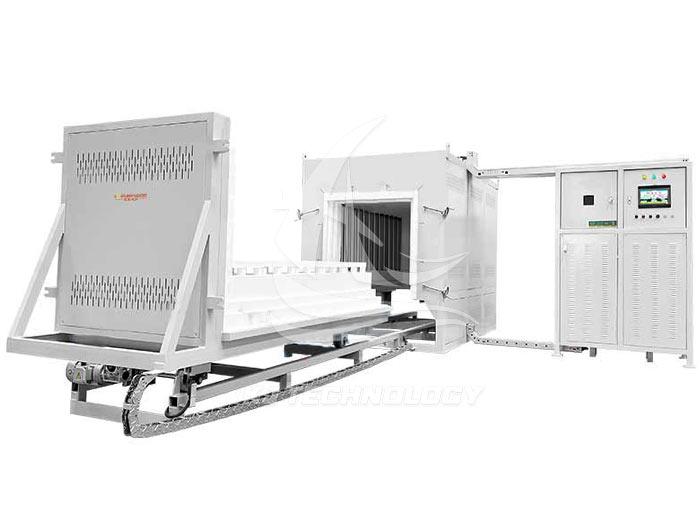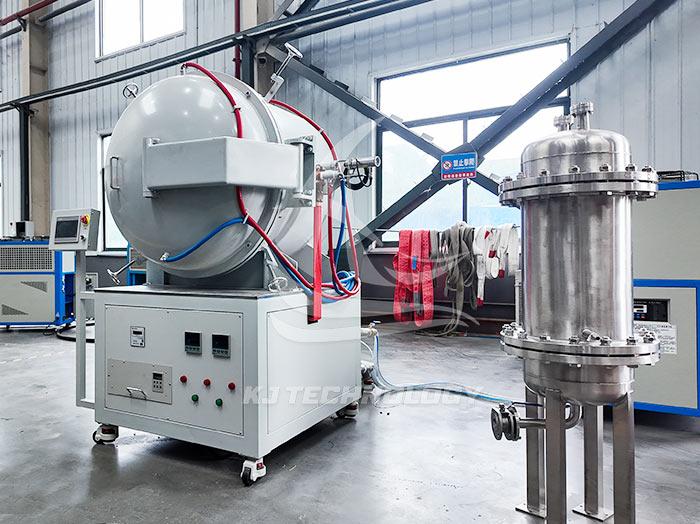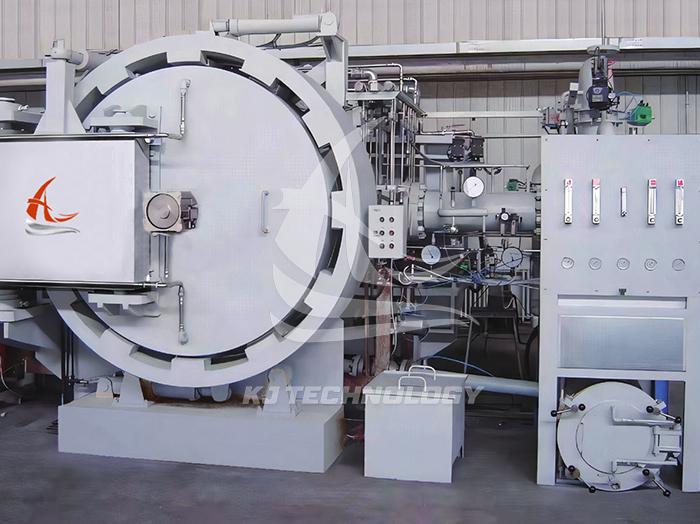Overview of Vacuum Atmosphere Heat Treatment Furnace
 07-14-2025 Author: KJ technology
07-14-2025 Author: KJ technology
Vacuum Atmosphere Heat Treatment Furnace: Technical Principles, Core Advantages, and Multi Field Application Analysis.
1. Technical principle: Precise synergy of vacuum and atmosphere control
The vacuum atmosphere heat treatment furnace provides a non oxidizing and low pollution heat treatment environment for materials through the synergistic effect of the vacuum system and atmosphere control system. The core principle can be divided into the following steps:
Construction of Vacuum Environment
The vacuum pump extracts gas from the furnace, creating a high vacuum environment as low as 1.33 × 10 ⁻ ³ Pa, effectively removing active gases such as oxygen and water vapor, and preventing material oxidation, decarburization, or carburization.
Vacuum environment can also remove impurities such as phosphorus shavings and grease on the surface of materials, achieving surface brightness purification.
Accurate control of atmosphere
According to the process requirements, inert gases (such as nitrogen, argon), reducing gases (such as hydrogen), or specific reaction gases can be filled into the furnace to form a protective or reactive atmosphere.
For example, injecting a mixture of methane and nitrogen gas into the carburizing process can achieve gradient control of carbon concentration on the material surface.
High temperature heating and temperature control
By using high-temperature resistant components such as silicon molybdenum rods and graphite heaters, combined with a microprocessor temperature control system, precise temperature control (± 1 ℃) and uniform distribution can be achieved.
The heating rate can reach 1 ℃/h to 40 ℃/min, supporting rapid heating and programmed insulation curves.
Cooling System Design
The combination of air-cooled circulation system and water-cooled structure enables rapid cooling or controllable cooling rate, meeting the requirements of quenching, annealing and other processes.
2. Core advantages: Quality improvement and process expansion
The vacuum atmosphere heat treatment furnace significantly improves material properties and process flexibility through dual optimization of environmental control and temperature management
Non oxidizing treatment ensures the purity of materials
Vacuum environment eliminates the risk of oxidation, avoids the formation of oxide film or decarburization layer on the metal surface, and preserves the original mechanical properties of the material.
For example, after vacuum heat treatment, the risk of hydrogen embrittlement on the surface of titanium alloys is reduced, and the fatigue life is increased by more than 30%.
Controllable atmosphere, achieving special craftsmanship
Under inert atmosphere protection, active metals such as beryllium and thorium can be sintered to prevent material from reacting with gases.
A reducing atmosphere (such as hydrogen) can be used for deoxidation treatment of hard alloys to enhance material density.
Excellent temperature uniformity ensures process stability
The design of polycrystalline alumina fiber furnace and ceramic fiber insulation layer ensures a temperature uniformity of ± 1 ℃ inside the furnace, reducing material deformation caused by thermal stress.
For example, after vacuum heat treatment, the dimensional accuracy of aircraft engine turbine blades is controlled within ± 0.05mm.
Energy saving and efficient, reducing operating costs
Imported fiber furnace and double-layer water-cooled shell structure increase thermal efficiency by 20% and reduce energy consumption by 15%.
Design of circulating water system and hot water circulating water pump to achieve the reuse of water resources and further optimize operating costs.
3. Typical application scenario: Full coverage from laboratory to industrial production
The vacuum atmosphere heat treatment furnace, with its technological advantages, has become a key equipment for material processing in multiple fields:
Heat treatment of metal materials
Annealing and tempering: eliminate internal stress in metals and improve toughness. For example, after vacuum annealing, the hardness uniformity of mold steel increases by 2 HRC units.
Solid solution and aging treatment: optimizing the distribution of alloy elements. After vacuum solution treatment, the high-temperature strength of nickel based high-temperature alloys increases by 10%.
Vacuum brazing: achieving the connection of dissimilar materials. For example, the combustion chamber of an aircraft engine adopts vacuum brazing technology, and the joint strength reaches over 90% of the base material.
Powder metallurgy and ceramic sintering
Hard alloy sintering: Under vacuum or hydrogen atmosphere, tungsten carbide and cobalt powder are densified and sintered, with a hardness of HRA 92 or above.
Preparation of ceramic materials: Avoid oxidation and improve density. After vacuum sintering, the density of alumina ceramics reaches 99.5% of the theoretical value.
Electronic Industry and New Material Research and Development
Semiconductor device manufacturing: transistor annealing is carried out in a nitrogen atmosphere to reduce metal migration and improve device reliability.
Synthesis of lithium-ion battery materials: Vacuum sintered lithium iron phosphate cathode material, with a 15% increase in crystallinity and a 200 cycle life extension.
Research on High Temperature Superconducting Materials: Synthesis of Yttrium Barium Copper Oxygen (YBCO) Superconductor under Argon Protection, with a 30% increase in critical current density.
Aerospace and high-end manufacturing
Titanium alloy heat treatment: Vacuum annealing eliminates processing stress and meets the high temperature requirements of 350 ℃ for aircraft structural components.
High temperature alloy blade treatment: vacuum solution+aging treatment to maintain a yield strength of 800MPa at 1000 ℃.
4. Technological development trend: intelligence and multifunctionality
With the increasing demand for Industry 4.0 and new material research and development, vacuum atmosphere heat treatment furnaces are evolving in the following directions:
Intelligent control upgrade
Integrate IoT technology to achieve remote monitoring and automatic optimization of process parameters. For example, using AI algorithms to predict material deformation trends and dynamically adjust cooling rates.
Multi functional module expansion
Develop a vacuum atmosphere composite furnace that supports switching between vacuum, inert gas, or reactive gas environments within the same equipment, adapting to multiple process requirements.
For example, a certain model of furnace body can achieve integrated operation of vacuum sintering, hydrogen reduction, and nitrogen quenching, and the process switching time can be shortened to 10 minutes.
Breakthrough in ultra-high temperature and ultra-high pressure technology
Develop ultra-high temperature vacuum furnaces above 2000 ℃ to meet the sintering needs of new materials such as silicon carbide fibers and boron nitride ceramics.
Explore a 10MPa high-pressure vacuum furnace to achieve high-pressure sintering of metal ceramic composite materials and improve interfacial bonding strength.
5. Conclusion: Core Equipment of Modern Industry
The vacuum atmosphere heat treatment furnace provides high-quality and highly flexible heat treatment solutions for fields such as metals, ceramics, and electronic materials through the precise combination of vacuum environment and atmosphere control. Its technological advantages are not only reflected in the improvement of material properties, but also promote the innovative development of high-end industries such as aerospace, new energy, and semiconductors. With the deepening trend of intelligence and multifunctionality, vacuum atmosphere heat treatment furnaces will continue to serve as the core equipment of modern industry, assisting breakthroughs in materials science and manufacturing technology.








